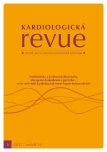Renal denervation and its role in the treatment of resistant hypertension
Authors:
P. Vysočanová
Published in:
Kardiol Rev Int Med 2012, 14(3): 207-210
Category:
Overview
Hypertension is a major health problem affecting approximately 35% of adult people. Some patients with hypertension are difficult to control despite the use of combinations of antihypertensive drugs and are considered as resistant to treatment. Hypertension is defined as resistant to treatment when a therapy of at least three drugs (including a diuretic) at correct doses has failed to control blood pressure to goal levels. The treatment of resistant hypertension includes life-style changes, the elimination of exogenous factors and secondary causes of hypertension, also the use of the maximum tolerated doses of combined antihypertensive drugs. Increasing understanding of the pathophysiology of hypertension may allow the development of new interventional method for the treatment of resistant hypertension. Renal denervation is a new invasive method of catheter based radiofrequency ablation of the sympathetic nerves located around renal arteries. The initial clinical experiences showed promising and long lasting decrease in blood pressures. Nevertheless renal denervation is still an experimental method to be used only in specialized research centers.
Keywords:
resistant hypertension – renal denervation – treatment
Sources
1. Cifkova R, Skodova Z, Bruthans J et al. Longitudinal trends in cardiovascular mortality and blood pressure levels, prevalence, awareness, treatment, and control of hypertension in the Czech population from 1985 to 2007/2008. J Hypertens 2010; 28: 2196–2203.
2. Lewington S, Clarke R, Qizilbash N et al. Prospective Study Collaboration. Age-specific relevance of usual blood pressure to vascular mortality: a meta-analysis of individual data for one milion adults in 61 prospective studies. Lancet 2002; 360: 1903–1913.
3. de la Sierra A, Segura J, Banegas JR et al. Clinical features of 8,295 patients with resistant hypertension classified on the basis of ambulatory blood pressure monitoring. Hypertension 2011; 57: 892–902.
4. Lloyd-Jones DM, Evans JC, Larson MG et al. Treatment and control of hypertension in the community: a prospective analysis. Hypertension 2002; 40: 640–646.
5. Calhoun DA, Jones D, Textor S et al. Resistant hypertension: diagnosis, evaluation, and treatment: a scientific statement from the American Heart Association Professional Education Committee of the Council for High Blood Pressure Research. Circulation 2008; 117: e510–e526.
6. Pickering TG, Hall JE, Appel LJ et al. Recommendations for blood pressure measurement in humans and experimental animals: part 1: blood pressure measurement in humans: a statement for professionals from the Subcommittee of Professional and Public Education of the American Heart Association Council on High Blood Pressure Research. Circulation 2005; 111: 697–716.
7. Farsky S, Benova K, Krausova D et al. Clinical blood pressure measurement verification when comparing a Tensoval duo control device with a mercury sphygmomanometer in patients suffering from atrial fibrillation. Blood Press Monit 2011; 16: 252–257.
8. Bovet P, Hungerbuhler P, Quilindo J et al. Systematic difference between blood pressure readings caused by cuff type. Hypertension 1994; 24: 786–792.
9. Pimenta E, Gaddam KK, Oparil S et al. Effects of dietary sodium reduction on blood pressure in subjects with resistant hypertension: results from randomized trial. Hypertension 2009; 54: 475–481.
10. Pimenta E, Calhoun DA. Treatment of resistant hypertension. J Hypertens 2010; 28: 2194–2195.
11. Park J, Campese V. Clinical characteristic of resistant hypertension: the importance of compliance and the role of diagnostic evaluation in delineating pathogenesis. J Clin Hypertens 2007; 9 (Suppl 1): 7–12.
12. Štrajch B, Chytil L, Kurcová I et al. Jak posoudit non-compliance k farmakoterapii u těžké rezistentní hypertenze? Cor Vasa 2011; 53: 429–432.
13. Rossi GP, Bernini G, Caliumi C et al. A prospective study of the prevalence of primary aldosteronism in 1,125 hypertensive patients. J Am Coll Cardiol 2006; 48: 2293–2300.
14. Garg JP, Elliott WJ, Folker A et al. Resistant hypertension revisited: a comparison of two university--based cohorts. Am J Hypertens 2005; 18: 619–626.
15. Sobotka PA, Mahfoud F, Schlaich MP et al. Sympatho-renal axis in chronic disease. Clin Res Cardiol 2011; 100: 1049–1057.
16. DiBona GF, Kopp UC. Neural control of renal function. Physiol Rev 1997; 77: 75–197.
17. Hoobler SW, Manning JT, Paine WG et al. The effects of splanchnicectomy on the blood pressure in hypertension: a controlled study. Circulation 1951; 4: 173–183.
18. Schlaich MP, Sobotka PA, Krum H et al. Renal sympathetic-nerve ablation for uncontrolled hypertension. N Engl J Med 2009; 361: 932–934.
19. Simplicity HTN-1 Investigators. Catheter-based renal sympathetic denervation for resistant hypertension: durability of blood pressure reduction out to 24 months. Hypertension 2011; 57: 911–917.
20. Esler MD, Krum H, Sobotka PA et al. Simplicity HTN-2 Investigators. Renal sympathetic denervation in patients with treatment-resistant hypertension: a randomised controlled trial. Lancet 2010; 376: 1903–1909.
21. Widimský P, Filipovský J, Widimský J et al. Expert consensus statement of the Czech Society of Cardiology and the Czech Society of Hypertension on catheter-based sympathetic renal denervation procedures in the Czech Republic. Cor Vasa 2012; 54: e108–e112.
22. Wolf-Maier K, Cooper RS, Kramer H et al. Hypertension treatment and control in five European countries, Canada and the United States. Hypertension 2004; 43: 10–17.
23. Widimský J, Sachová M, Lánská V. Profil rizikových faktorů vybraného souboru hypertoniků v ordinacích praktických lékařů a účinnost a snášenlivost léčebné strategie s použitím rilmenidinu. Výsledky 2. a 3. fáze průzkumu DRIVE. Prakt Lék 2005; 85: 261–267.
Labels
Paediatric cardiology Internal medicine Cardiac surgery CardiologyArticle was published in
Cardiology Review

2012 Issue 3
Most read in this issue
- Importance of determining apolipoproteins B and A-1 in clinical practice
- Ticagrelor in patients with acute coronary syndrome
- Hypertriglyceridemia and cardiovascular risk
- Troponin as a prognostic risk factor in patients hospitalized for decompensation of chronic systolic heart failure
